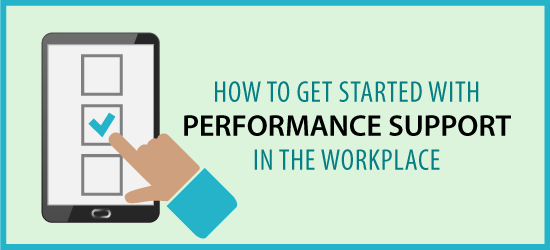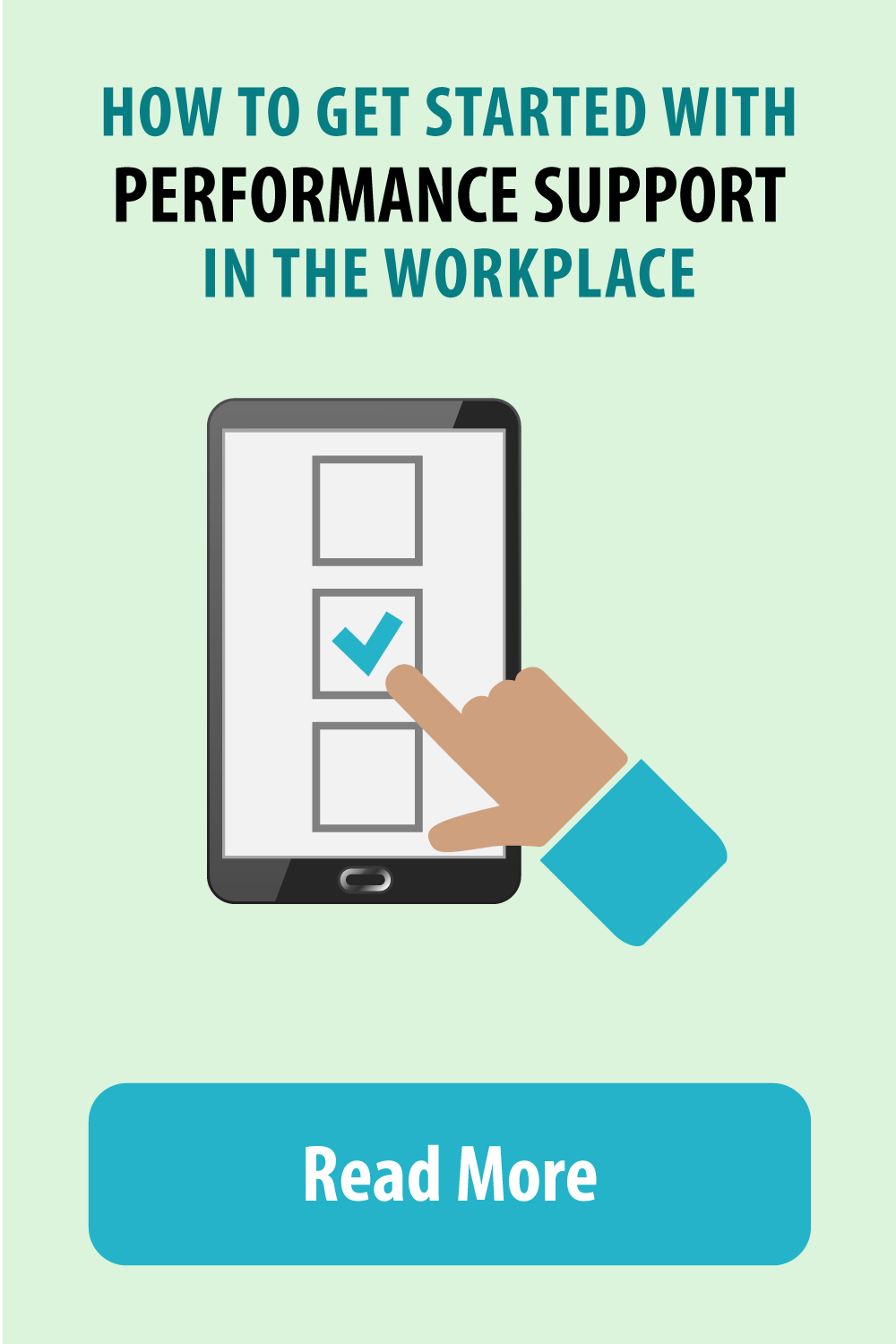
When you buy a piece of furniture that needs to be assembled, you follow the enclosed instructions to put it together. It makes more sense to follow the instructions step-by-step than to memorize them because there is no need to retain the information. The assistance you get from the manual is similar to performance support in the workplace.
Performance Support as a Memory Aid
Performance support is necessary because of the limits of human memory. At work, performance support can close a gap that may arise in the context of performing a task. (Read The Importance of Context in Learning.) It includes any system, resources or tools that assist memory during work performance. For example, when providing help desk support a person may refer to a database of technical issues and solutions. Or when someone performs a medical procedure, they may use a checklist to ensure they don’t skip a step. Users are not tested on performance support. Its effectiveness is demonstrated in the moment.
Performance Support as Learning in the Flow of Work
Performance support might also be helpful prior to performing a task, often referred to as learning in the flow of work. For example, when sales representatives review key points they want to present before making a routine sales call they may need just-in-time training. Or when a mechanic watches a video on their phone to learn to perform a unique type of repair. These shorter tutorials that cover one objective are often referred to as microlearning. See What is Microlearning?
Analysis for Performance Support
How can you tell when performance support is the most effective solution or when formal learning interventions would be best? A request for solving a workplace performance solution typically arises from issues, such as:
- Employees are having difficulties solving certain types of problems
- Workers are making too many errors
- Staff are must remember more information than is possible to retain
- Customers are complaining about poor service
- There has been a change in enterprise-wide procedures, products, software or relevant regulations
You can often identify the causes of a performance problem by collaborating with key stakeholders, audience members, and subject matter experts. In some cases, a problem cannot be solved with a training or performance support solution. For example, if an organization has many inefficient procedures, these issues must be addressed outside of training or support.
The analysis starts with the question, what is the ideal performance and what stops people from doing it? You then compares this with the current performance and why it occurs. This is your performance gap. You need to find out the best way to close the gap between the ideal and the current situation.
To best understand where problems occur, you can conduct a task analysis to deconstruct the tasks involved in the workflow where there are issues. This will help you discover whether one or more support interventions will solve the problem. A task analysis breaks down complex tasks into simpler steps. It also captures the knowledge needed to perform the steps.
Rapid Task Analysis
In their book, Innovative Performance Support, authors Gottfredson and Mosher write about conducting a rapid task analysis (RTA). This has the purpose of quickly identifying and sequencing higher level tasks rather than focusing on the details at first. It provides an overview for selecting the best type of performance support or training strategies and identifies where they are needed.
The RTA has three objectives:
1. Identify the job-specific tasks. The goal of deconstructing the job tasks is to understand what is involved and where to provide support. Using this rapid approach, you don’t identify all of the steps of each task at this stage. This lets you get a quick overview perspective of things. You can then identify the detailed steps of each task later in the process.
2. Capture related concepts. Capture the higher-level concepts associated with each task. These describe what the task is, where the task fits in to the overall flow and its importance to the organization. Identifying the associated concepts provides the context of how tasks fit into the big picture.
3. Organize the tasks and concepts into meaningful business processes. In this phase, you group the tasks and concepts into logical units or processes.
After identifying the tasks and concepts, map them to the different job roles that require the tasks (Gottfredson & Mosher, 2010).
When to Use Performance Support
You may use performance support as one part of the learning landscape when your needs analysis shows that employees may benefit from consistent timely support in the workflow. It makes sense to provide support rather than training, when you know or suspect that an external memory aid is will close the performance gap.
Here are some examples of when performance support is most likely the best solution:
- When accuracy is critical and errors are risky. Example: Assembling military equipment.
- When a work task is performed infrequently, making it difficult to remember. Example: Filling out yearly employee forms.
- When a work task is error prone, so that mistakes are made too often. Example: Performing routine medical procedures in a hospital.
- When there are multiple decision points or many steps. Example: Determining the best type of insurance for a particular need.
- When procedures or tasks are changing. Example: When two companies merge, there may be a temporary way of performing tasks that could benefit from support.
- When workers have a low level of literacy. Example: Using visuals to show how to perform tasks can improve performance for people with low literacy, such as those who speak another language.
- When training is not available for performing complex tasks. Example: Newly promoted managers need to determine project life cycle estimates but training is not immediately available.
- When there are budget constraints, even though training may be a better alternative. Example: Creating a document that lists how to perform the most used features in a software application rather than providing more expensive online tutorials.
Conclusion
Don’t underestimate performance support. There are many situations where it can replace formal training and work as a primary intervention (see Lanese and Nguyen, 2012). It encourages self-directed learning at work and enables people to perform more effectively. For further reading, see Mobile Learning 101 and A New Paradigm for Corporate Training: Learning in the Flow of Work.
What kind of results are you seeing with performance support? Share in the Comments below.
References:
- Gottfredson, C. & Mosher, B. Innovative Performance Support: Strategies and Practices for Learning in the Workflow. Columbus: McGraw-Hill, 2010.
- Lanese, L. & Frank Nguyen, F. “The Journey from Formal Learning to Performance Support.” Performance Improvement, vol. 51, no. 5, May/June 2012
- Willmore, J. Job Aids Basics. Alexandria: ATD Publishing, 2018.



Thank you for this article. I work in an office that is designed around performance support (it’s in our departmental name as well) for instructional and non-instructional evaluations. The strategies listed here would definitely redirect the structure of how we identify and handle issues that arise in our workload.
The analysis strategies, especially Rapid Task Analysis, is a method we should implement given the quick turnaround required of us for faster results. An RTA can be developed around the parameters of the evaluation process for both teachers and non-instructional employees, which will alleviate the extra steps we currently have to resolve problems.
Excellent, Paul. Thanks for the additional information.
Best,
Connie
Great article still today. Some of the cool things that have changed is the larger adoption of responsive authoring as well which really opens up the abilities and options to address this in an easier way.
At dominKnow, we’ve long thought, hey why can’t your authoring tool you use for normal courses, be used for all sorts of learning interventions like performance support. Until more recently, it really couldn’t as “slides” don’t often fit the motif for performance support, but with responsive things change.
We even got crazy and built our own support knowledge base for our product with our product! Crazy I know 🙂 – (sample version of this: http://helpdocs.dominknow.com/KB/
Exciting times as these changes in technology help us to use the content in multiple ways and save time without having to “redo” things for each situational experience (or forgo an approach due to lack of time!)
Amazing article. I got curious after reading on performance support and thus decided to dig deeper into it. I started with finding out the utility of a performance support system and then finally learned how to go about creating it. I have compiled my findings in three blog posts. You can find them here:
http://academy.whatfix.com/performance-support-systems/
http://academy.whatfix.com/electronic-performance-support-system-characteristics/
http://academy.whatfix.com/creating-electronic-performance-support-tools/
Thanks Connie. I read the resources that you suggested. It’s strange that such interesting topic as PS/EPSS wasn’t researched deeply. I only found works done by Eran Gal and Rafi Nachmias and one research by Frank Nguyen that you have to pay to get access.
I like the work that Bob Mosher and Conrad Gottfredson do in explaining it with the five moments of need. Also, Allison Rossett. These are practitioners and authors. Also, the eLearning Guild has a Performance Support conference. Hope this helps.
Very good article. I’m new to PS. Could you point me some valuable reports/research/info on this subject?
Hi Steve,
I’m not sure I understand your question. Are you asking whether there are good examples of performance support? Or good examples of the same app in the cloud, desktop, phone and wearable. I have not seen one app that does it all. But maybe the Quantified Self apps provide personal performance support. I’m not sure if this is what you are looking for, but this article refers to 5 apps for instructional designers: http://elearningindustry.com/top-5-performance-support-apps-for-learning-designers. Sorry if I’m misunderstanding you.
Connie
Hi Connie, great post (apologies for being a bit late to the party!) You mention that ‘you can now provide technology-based support in the cloud, embedded into desktop applications, via mobile phones and through wearable technology’ for performance support. Have you seen any great examples of this recently? It would be fantastic to see them if you have.
LOL. Don’t feel bad about it, Joe. You’re definition is a TON better than mine and I love it. Of course, I do know that it’s much more than a job aid and worked in the field when EPSSs were big. I think I was just trying to name it in a way that people could relate to. This is a community, so it’s good to hear what you have to say. Thanks for your important contribution.
Best
Connie
Hi Tricia,
Yes, I know people have been providing performance support for decades. But I’m glad it was a bit of a reminder for you. Would love to share the kinds of tasks you provide performance support for, Tricia.
Connie
Thanks Connie! A lot of us already provide performance support of one sort or another. This is a nice reminder or checklist of situations to consider applying a performance support solution.
Connie,
You know, I am a huge fan. Yet I must take exception to your definition of performance support. i.e. ‘sometimes referred to as a job aid”.
Performance Support is a systems based discipline which investigates and improves human performance in the work place. To reduce an entire field of study to a job aid, does have a tendency to trivialize it.
When you consider the multiple factors that influence a person’s job performance, then consider how those factors interact with each other, you end up with a relatively complex problem set worthy of serious study.
I feel badly about taking you to task, however I am a Performance Technologist as well as an Instructional Designer.
Best Regards, and I still look forward to your upcoming opus.
Joe
Hi Greg,
This particular illustration was from a stock photo site. It’s very easy to find illustrations like this by filtering your search for “illustrations.” Here is a list of some of my favorite stock photo sites, though most have their fair share of cheesy photos.
Best Paid Stock Photo and Illustration Sites
Email me through the contact form if you need more help on this.
Regards,
Connie
Hi Connie!
Great information (and design as always). I was wondering…the illustration with this article-is it from a clip art pack that can be purchased, or did you have it made specifically for your site?
Thanks!
–greg
Thank you, Emmanuel. I enjoy interacting with you on The eLearning Coach Facebook Page!
Connie
Hello Connie, you are a great person to follow because you have great ideas to share with people who want to take your advice through publication like this.
Thank you.